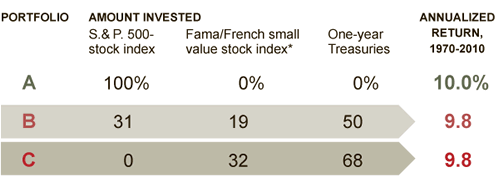I’ve written a little bit in the past about including small-value stocks to your investment portfolio. “Small” means companies with a relatively smaller market cap (total market value) – definitions vary from being the bottom 10% by capitalization or being worth less than $1 billion. “Value” stocks are those that tend to trade at a lower price relative to others when measured against markers like earnings, dividend yield, sales, or book value.
This NYTimes article on the portfolio of investment advisor and author Larry Swedroe included some concise examples of how significant this small-value premium has been in the past. For one, small-value stocks outperformed the S&P 500 by about 4% annually from 1927-2010.
Put another way, by making a portfolio using small-value stocks and US Treasury bonds, you could have gotten similar performance to the S&P 500 with much lower risk. Specifically, you could have held 1/3rd small-value and 2/3rd Treasury bonds and had close to the same return as the S&P 500 over a 40-year period from 1970-2010. This chart summarizes:

Source: Buckingham Asset Management, New York Times
Will this “small-value premium” continue to persist? There are a few theories out there. One is behavioral, where small-value companies tend to be the more ignored and unpopular companies and thus are consistently underpriced. Another is based on the fact that small-value companies are simply riskier, and thus investors demand a higher return for holding them.
I happen to believe that there is something enduring about small-value stocks, but the size of my bet on that belief is relatively small – only about 5% of my target stock allocation. But I also know that you need to hold a very strong belief in whatever internal explanation you have for the outperformance. Otherwise, when small-value is the dumps for a while relative to the Current Hot Thing – and it will be, one day – you’ll sell and lose any potential edge.
 The Best Credit Card Bonus Offers – 2025
The Best Credit Card Bonus Offers – 2025 Big List of Free Stocks from Brokerage Apps
Big List of Free Stocks from Brokerage Apps Best Interest Rates on Cash - 2025
Best Interest Rates on Cash - 2025 Free Credit Scores x 3 + Free Credit Monitoring
Free Credit Scores x 3 + Free Credit Monitoring Best No Fee 0% APR Balance Transfer Offers
Best No Fee 0% APR Balance Transfer Offers Little-Known Cellular Data Plans That Can Save Big Money
Little-Known Cellular Data Plans That Can Save Big Money How To Haggle Your Cable or Direct TV Bill
How To Haggle Your Cable or Direct TV Bill Big List of Free Consumer Data Reports (Credit, Rent, Work)
Big List of Free Consumer Data Reports (Credit, Rent, Work)
In the article the author writes that you could not recreate the performance using Vanguard’s offerings and that Mr. Swedroe offered “a different approach that would at least allow a Vanguard investor to reduce risk significantly without sacrificing returns.”
This approach is not outlined in the article – does anyone know what it is?
Vanguard’s small value fund isn’t terribly small or valuey and has a large proportion of REITs. Less of the small and value risks, thus less of the small and value premiums.
DFA has the edge with small value, which isn’t a surprise because of the Fama/French influence. However, you need an advisor to access to DFA funds.
There are some small value ETFs, but I’ve read criticisms of some of them as not being diversified enough – not enough companies.
For what it’s worth, this company’s website gives an interesting comparison and ranking of the options available:
http://www.altruistfa.com/USsmallcapvaluefunds.htm
Good point Dan. Even I am curious.
Small-value stocks can be an effective investment. It is noteworthy that they outperform the S&P. Still, I would only make small-value stocks a small portion of my portfolio.
Seems like one could replace one-year Treasury bills with CDs for slightly better returns. That would especially be the case in today’s environment when 1-year Treasuries have yields of only around 0.12%.
Because small-cap stocks have noticeably outperformed large-cap stocks over time, it does not surprise me at all that owning a portfolio of 32% stocks (all small value) over the past 41 years (1970-2010) earned the same return as one that had a larger percentage allocated to stocks, with some or all of the stock portion in large caps.
The problem is, in my opinion, that a very large portion of investors using this small-cap value strategy would not be able to stick with it during the times when the strategy is getting creamed. Small-cap value stocks have greater volatility than large-cap stocks and can have performance that is vastly different from what large-cap stocks (say, the S&P 500) are doing.
For example, per the NYT article referred to above, the S&P 500 earned about 29% in 1998 while the small-cap value index lost about 10%. With large-cap stocks (especially growth stocks) obliterating small-cap stocks (and bonds) over several years in the late ’90’s, how many investors would have been able to stick with the small-cap value strategy?